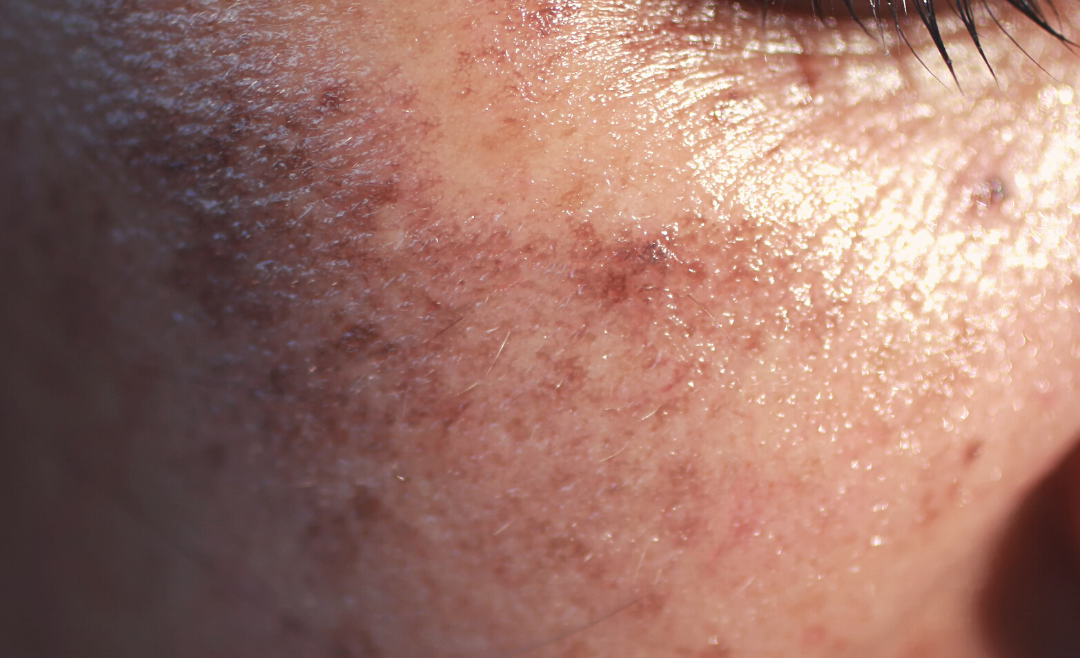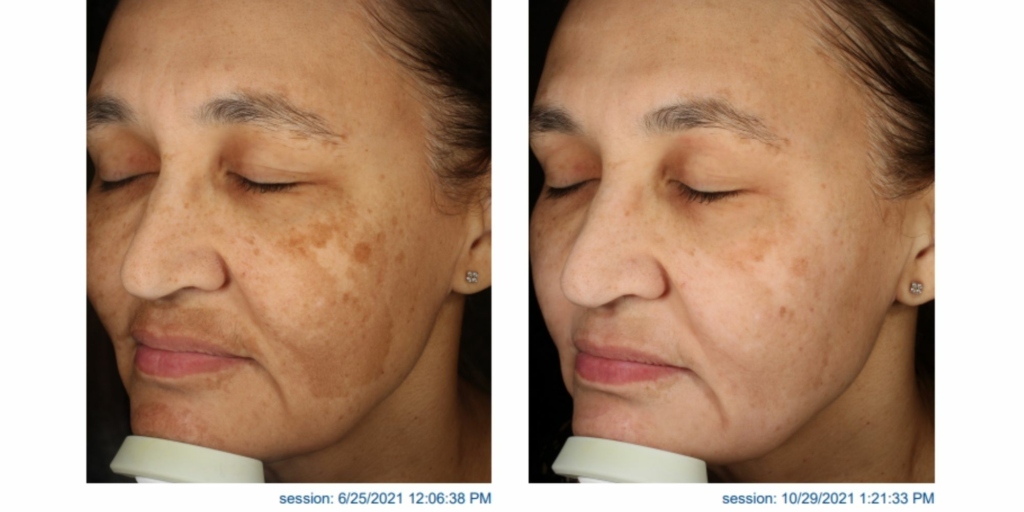By Doctor Marisa Heyns
Over the last 10 years, there has been a research boom increasing our knowledge on how pigmentation works, and how we can finally go about treating hyperpigmentation successfully.
I have developed a love-hate relationship with hyperpigmentation over the years of practicing aesthetic medicine. I love it, because it reflects, to a degree, the amazing complexity of the skin. Our skins are not just a tapestry that covers our bodies. It is a highly intelligent live organ that needs to be looked after.
I also really loathe hyperpigmentation as it can negatively affect the way we feel about ourselves. I, myself, suffer from hyperpigmentation (Melasma) and although I have it very mild compared to some of my clients, I have always been aware of this pigment mask-like blemish on my face which I feel I need to keep covered up.
One can imagine the negative psychological impact it has on both men and women feeling the consistent need to hide and cover-up, never being able to just feel free without make-up.
So, let’s talk about how to treat hyperpigmentation with the new Dermamelan protocol.
Table of contents
- THE NEW DERMAMELAN DEPIGMENTATION PROTOCOL
- THE DIFFERENCE BETWEEN PIGMENTATION AND HYPERPIGMENTATION
- WHAT CAUSES HYPERPIGMENTATION?
- DIFFERENT TYPES OF HYPERPIGMENTATION
- MANAGING HYPERPIGMENTATION
- MESOESTETIC’S NEW DERMAMELAN
- HOW DOES DERMAMELAN WORK?
- DERMAMELAN DEPIGMENTATION RESULTS
- WILL PIGMENTATION BE REMOVED FOREVER?
- IN CONCLUSION
THE NEW DERMAMELAN DEPIGMENTATION PROTOCOL
Mesoestetic’s Dermamelan (considered the gold standard in treating pigmentation in all skin types) has recently undergone a facelift. A new and improved formula, new ingredients, new packaging, and a shortened protocol of 4 months only!
For those of you who have personally experienced the results from either Dermamelan or its little sister, Cosmelan, I am sure you will agree, the results are AMAZING. But eish – it requires a lot of hard work. This is not a treatment for slaves to instant gratification, or for those who struggle to hold a long-term commitment. However, if you can stick to the depigmentation treatment protocol, the results are absolutely incredible and will most certainly change your life.
But before I continue to sing the praises of this potentially life-changing treatment, I think it is very important that we deepen our understanding of hyperpigmentation, in order to understand how and why Dermamelan works.
DIFFERENCE BETWEEN PIGMENTATION AND HYPERPIGMENTATION
There is a very big difference between pigmentation and hyperpigmentation. Pigment production also known as melanogenesis is a normal physiological process, whereby skin pigment cells called melanocytes are activated to make pigment (melanin). This process occurs in an orderly consistent manner and serves to protect us from harmful UV radiation. Generally, the darker our skin tones, the better we are at making pigment, and the greater protection against sun damage.
But as we age, this vital function becomes a bit deranged. This occurrence or event is called Hyperpigmentation and is considered a chronic skin condition for which we have no cure. The underlying pathology of hyperpigmentation includes a variety of complex pathways with a common final destination: increased and abnormal deposition of pigment leading to blotchy, mask-like patterns, that can make the appearance stained.
WHAT CAUSES HYPERPIGMENTATION?
There are many causes of hyperpigmentation and unfortunately, they do not occur in isolation which means you can have an exaggerated acute or chronic pattern of pigment production. Most causes are related to inflammation, genetic predisposition, and damage to the skin’s barrier. Well-known enemies include UV radiation, infrared radiation, and high-intensity visible light. Not only do they cause pigmentation, but they also weaken the skin barrier and damage the DNA, responsible for maintaining healthy skin!
DIFFERENT TYPES OF HYPERPIGMENTATION
Melasma
The dreaded mask-like pigmentation disorder that covers the forehead, the cheeks, and the top lip. Until recently, we thought its cause was purely hormone-related. Unfortunately, this was not the case! Clients with melasma have inherent differences in the structure and constituents of their skins compared to those who don’t.
Predisposed melasma skins have an increased number of oestrogen receptors. Hence, a greater sensitivity to circulating hormones. They show greater inflammatory responses to skin damage and inflammation (external and internal). And they have weaker skin barriers. All of this means that when exposed to any cause of pigmentation or associated factors, your skin will have a greater risk of developing pigmentation.
Post-inflammatory hyperpigmentation:
Another condition that is poorly understood, but known to show a preference for specific skin types. If you have the ability to tan well (Mediterranean skin, or if you are of Indian or African descent) you are much, much more likely to develop pigmentation after an inflammatory event. Inflammation can be due to certain skin conditions such as acne or skin rashes like eczema. It can occur as a result of harsh skin treatments from chemical peels, lasers, or heat devices. You can get it just from picking your skin.
Sun damage:
We are all aware of the ageing effects of sun damage, especially in South Africa. Not only does sun damage cause hyperpigmentation, but it also causes severe damage to the skin structure. Brown, tanned, leathery skin – it is not a pretty (or healthy) sight!
Freckles:
Unfortunately, there is not much we can do about freckles. They are genetically predetermined spots of pigment that you cannot get rid of. However, sun damage can certainly make them darker and more visible.
MANAGING HYPERPIGMENTATION
So once hyperpigmentation has set in, it will progress and may worsen with time if not managed or treated correctly. One thing I always explain to clients is this: The skin operates 24/7. This means that the negative forces of hyperpigmentation are also at play on a daily basis. We cannot expect hyperpigmentation to improve if we do not treat it on a DAILY basis!
MESOESTETIC’S NEW DERMAMELAN
What I love about the Mesoestetic brand, is their understanding that an effective hyperpigmentation treatment protocol will only work if it is applied daily. The Dermamelan protocol requires you to step up, commit by saying “I Do” and stick to a daily routine to combat your hyperpigmentation. It really takes two to tango here, you and us.
HOW DOES DERMAMELAN WORK?
Think of all the pigment-controlling ingredients you have ever heard about: retinol, vitamin c, ferulic acid, niacinamide, Tyrosinase inhibitors like kojic acid, licorice extract, etc. The list goes on and on. Dermamelan has them all! These powerful ingredients act along ALL the known pathways that lead to hyperpigmentation by blocking the eventual activation of the melanocyte.
There are 3 steps involved in this journey to evening your skin tone:
Step one:
Involves the use of specifically chosen skincare products to optimise and prepare your skin for the big Dermamelan day. This phase normally takes between 4-6 weeks depending on the state and health of your skin. It is also a good time to become accustomed to wearing your sunscreen EVERY DAY for the rest of your life! Once you have made your commitment to seal the deal with Dermamelan, you would want to maintain your skin by protecting it with sunscreen.
Step two:
D-day! The Dermamelan treatment starts off with the application of a mask filled with potently high concentrations of depigmenting actives. To facilitate the penetration of the active ingredients, Mesoestetic has devised a nifty little ion mask that is applied on top of the Dermamelan mask cream. The ion mask contains copper and zinc to create an electrochemical current that ‘forces’ the active ingredients deep into the skin for an enhanced effect. After 4 hours (a massive reduction in application time compared to the 12 hours of the previous protocols), the mask and treatment are removed, and the skin is given a 2-day break to recover before we get to step three.
Step three:
The hard work starts! Now, this is probably the easiest and most difficult time, all in one. The easiest, because there is no thinking required. You apply the same 2 products twice a day (and your sunscreen during the day of course). The first product is the potently active Dermamelan treatment, and the second one is an amazing anti-inflammatory, anti-redness, and super moisturiser called Melan recovery. These two products go hand in hand, just like Batman and Robin. Trust me, you are not going to bust pigmentation if you do not use both.
You will also use very specific sun protection, the ultraprotective Melan 130 Pigment Control Sunscreen. This sunscreen has very high protection against all forms of sun and light radiation, and extra cover to UVB rays to prevent these damaging rays from activating melanocytes. There are no easier home care routines than this. The hard part is to not stop for 4 months. Even on the days you really do not feel like it. #relationshipgoals
DERMAMELAN DEPIGMENTATION RESULTS
Mind-blowing to say the least, but results may vary. You can expect visibly brighter, lighter skin with a more uniform skin tone. The first thing most clients say after experiencing their results is: ‘I don’t need to wear make-up anymore!’ What freedom to just be able to put on sunscreen and go!
An added bonus that almost all of our clients comment on, is the antiaging benefit of Dermamelan! Fewer wrinkles, and plumper, youthful, and more radiant skin are some of the added compliments our clients receive on completion of their protocol. The reason? Those anti-pigmentation ingredients are age busting as well!
WILL PIGMENTATION BE REMOVED FOREVER?
So here comes the tricky part. Of course, I would love to tell you that the new Dermamelan is the magic wand that will allow you to say goodbye to hyperpigmentation for good. That would however be a lie. And I would be very careful of anyone who promises you otherwise. My suggestion: be realistic about your expectations.
We need to own our pigmentation problems. Whether you have intentionally or non-intentionally played a role in the development of your hyperpigmentation; the degree, severity, the health of your skin, and the ongoing contributing factors, all play a role in how well or how poorly you will respond to any treatment. Dermamelan included.
Hyperpigmentation is like a scar, you cannot remove it, but treatments can make it look less visible. If you have severe, deep-seated pigmentation you should expect a mild yet visible improvement. Don’t set yourself up for major disappointment if it does not go away completely. I find that it is very easy to blame a treatment for not delivering a result when it really is how well you respond to the treatment. Having said that, at Nerina Wilkinson + Associates we really get amazing results when treating hyperpigmentation with Dermamelan.
Our clients’ skins start to show improvement from the first month and continue to improve throughout the protocol. We strive to optimise your skin to the best of our ability, and we continue to manage your skin throughout and after the Dermamelan treatment. And be mindful that when you stop applying the treatment, the pigmentation WILL return in most cases. Hence the need for ongoing management with products and treatments after the completion of the protocol.
IN CONCLUSION
Hyperpigmentation is here to stay (sorry). The new Dermamelan protocol, however, is truly amazing – especially when applied to dedicated and committed patients. Ready for a change? Come and see us for an assessment and consultation to best advise you on your journey to less pigmented and healthier-looking skin.
Contact Dr. Nerina Wilkinson + Associates at capetown@drnwilkinson.co.za to schedule your individualised depigmentation consultation and start your journey to your most beautiful, radiant self today.
Written by Dr. Marisa Heyns




